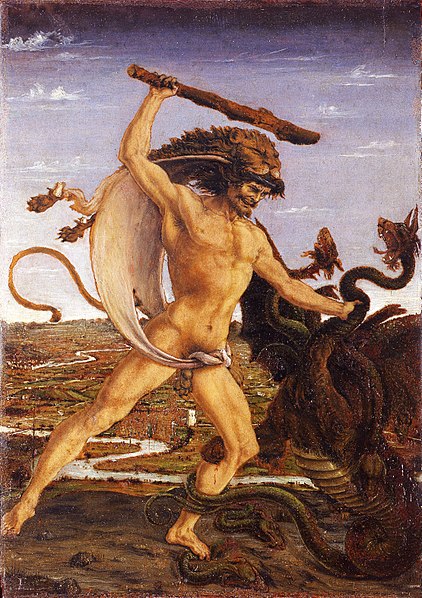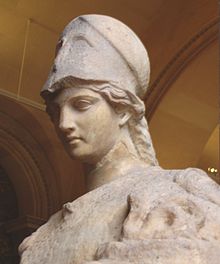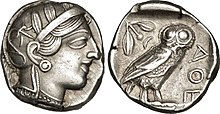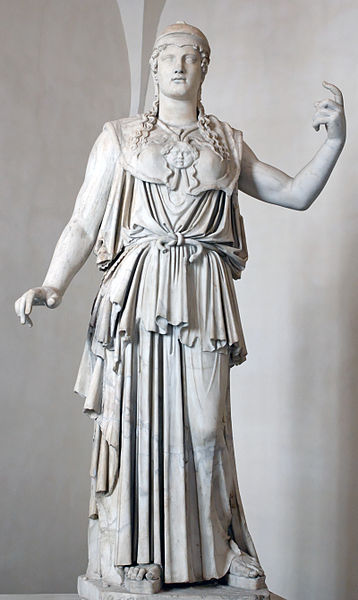|
Greek City of
Pergamon in
Mysia
Bronze 10mm (0.64 grams) Struck circa 310-282 B.C.
Reference: Sear 3958; B.M.C. 15.112,22-3; SNG France 1595-6; SNG Copenhagen
323-4
Head of young
Hercules
right, clad in lion’s skin.
ΠΕР, Head of
Athena right, in crested helmet.
Situated in the Kaikos valley, about 15 miles from the coast, Pergamon was a
city of uncertain origin and of no great importance before the time of Alexander
the Great. In the 3rd century B.C. it became the center of the independent
kingdom ruled by the Attalid dynasty founded by Philetairos. The city was
extended and beautified as the prosperity of the kingdom increased, and by the
late Hellenistic times Pergamon ranked as one of the great cultural centers of
the Greek world. After the end of the kingdom, 133 B.C., Pergamon became capital
of the Roman province of Asia.
You are bidding on the exact item pictured,
provided with a Certificate of Authenticity and Lifetime Guarantee of
Authenticity.
Hercules is the Roman name for the Greek
divine
hero Heracles
, who was the son of
Zeus (Roman equivalent
Jupiter
) and the mortal
Alcmene
. In
classical mythology
, Hercules is famous for his
strength and for his numerous far-ranging adventures.

The
Romans adapted the Greek hero’s iconography and myths for their literature and
art under the name Hercules. In later
Western art
and literature and in
popular culture
, Hercules is more
commonly used than Heracles as the name of the hero. Hercules was a
multifaceted figure with contradictory characteristics, which enabled later
artists and writers to pick and choose how to represent him. This article
provides an introduction to representations of Hercules in the
later tradition
.
Labors of Hercules
Hercules is known for his many adventures, which took him to the far reaches
of the
Greco-Roman world
. One cycle of these
adventures became
canonical
as the “Twelve Labours,” but the list
has variations. One traditional order of the labours is found in the
Bibliotheca
as follows:
- Slay the
Nemean Lion
.
- Slay the nine-headed
Lernaean Hydra
.
- Capture the
Golden Hind of Artemis
.
- Capture the
Erymanthian Boar
.
- Clean the Augean
stables in a single day.
- Slay the
Stymphalian Birds
.
- Capture the
Cretan Bull
.
- Steal the
Mares of Diomedes
.
- Obtain the girdle of
Hippolyta
, Queen of the
Amazons
.
- Obtain the cattle of the monster
Geryon
.
- Steal the apples of the
Hesperides
.
- Capture and bring back
Cerberus
.
The Latin
name Hercules was borrowed through
Etruscan
, where it is represented variously as
Heracle
, Hercle, and other forms. Hercules was
a favorite subject for
Etruscan art
, and appears often on
bronze mirrors
. The Etruscan form Herceler
derives from the Greek Heracles via
syncope
. A mild oath invoking Hercules (Hercule!
or Mehercle!) was a common
interjection
in
Classical Latin
.

Baby Hercules strangling a
snake
sent to
kill him in his
cradle
(Roman marble, 2nd century CE)
Hercules had a number of
myths
that were distinctly Roman. One of these
is Hercules’ defeat of
Cacus
, who was terrorizing the countryside of
Rome. The hero was associated with the
Aventine Hill
through his son
Aventinus
.
Mark Antony
considered him a personal patron
god, as did the emperor
Commodus
. Hercules received various forms of
religious veneration
, including as a
deity concerned with children and childbirth
,
in part because of myths about his precocious infancy, and in part because he
fathered countless children. Roman brides wore a special belt tied with the “knot
of Hercules“, which was supposed to be hard to untie. The comic
playwright Plautus
presents the myth of Hercules’
conception as a sex comedy in his play
Amphitryon
;
Seneca
wrote the tragedy Hercules Furens
about his bout with madness. During the
Roman Imperial era
, Hercules was worshipped
locally from Hispania
through
Gaul.
Medieval mythography
After the Roman Empire became
Christianized
, mythological narratives were
often reinterpreted as
allegory
, influenced by the philosophy of
late antiquity
. In the 4th century,
Servius
had described Hercules’ return from the
underworld as representing his ability to overcome earthly desires and vices, or
the earth itself as a consumer of bodies. In medieval mythography, Hercules was
one of the heroes seen as a strong role model who demonstrated both valor and
wisdom, with the monsters he battles as moral obstacles. One
glossator
noted that when
Hercules became a constellation
, he showed that
strength was necessary to gain entrance to Heaven.
Medieval mythography was written almost entirely in Latin, and original Greek
texts were little used as sources for Hercules’ myths.
Renaissance
mythography
The Renaissance
and the invention of the
printing press
brought a renewed interest in
and publication of Greek literature. Renaissance mythography drew more
extensively on the Greek tradition of Heracles, typically under the Romanized
name Hercules, or the alternate name
Alcides
. In a chapter of his book
Mythologiae (1567), the influential mythographer
Natale Conti
collected and summarized an
extensive range of myths concerning the birth, adventures, and death of the hero
under his Roman name Hercules. Conti begins his lengthy chapter on Hercules with
an overview description that continues the moralizing impulse of the Middle
Ages:
Hercules, who subdued and destroyed monsters, bandits, and criminals, was
justly famous and renowned for his great courage. His great and glorious
reputation was worldwide, and so firmly entrenched that he’ll always be
remembered. In fact the ancients honored him with his own temples, altars,
ceremonies, and priests. But it was his wisdom and great soul that earned
those honors; noble blood, physical strength, and political power just
aren’t good enough.

Helmeted Athena with the cista and Erichthonius in his serpent form.
Roman, first century (Louvre
Museum)
In
Greek religion
and
mythology
, Athena or Athene, also
referred to as Pallas Athena/Athene , is the goddess of wisdom, courage,
inspiration, civilization, law and justice, just warfare, mathematics, strength,
strategy, the arts, crafts, and skill.
Minerva
is the
Roman goddess
identified with
Athena.
Athena is also a shrewd companion of
heroes and is the
goddess
of heroic endeavour. She is the
virgin
patroness of
Athens
. The Athenians founded the
Parthenon
on the Acropolis of her namesake
city, Athens (Athena Parthenos), in her honour.
Athena’s veneration as the patron of Athens seems to have existed from the
earliest times, and was so persistent that archaic myths about her were recast
to adapt to cultural changes. In her role as a protector of the city (polis),
many people throughout the Greek world worshiped Athena as Athena Polias
(Ἀθηνᾶ Πολιάς “Athena of the city”). The city of
Athens
and the goddess Athena essentially bear
the same name, “Athenai” meaning “[many] Athenas”.
Patroness

Athenian
tetradrachm
representing the
goddess Athena

Athena
as the goddess of philosophy became an aspect of the cult in Classical Greece
during the late 5th century B.C. She is the patroness of various crafts,
especially of weaving
, as Athena Ergane, and was
honored as such at festivals such as
Chalceia
. The metalwork of weapons also fell
under her patronage. She led battles (Athena
Promachos or the warrior maiden Athena Parthenos) as the
disciplined, strategic side of war, in contrast to her brother
Ares, the patron of violence, bloodlust and slaughter—”the raw force
of war”. Athena’s wisdom includes the cunning intelligence (metis) of
such figures as Odysseus
. Not only was this version of Athena
the opposite of Ares in combat, it was also the polar opposite of the serene
earth goddess version of the deity, Athena Polias.
Athena appears in Greek mythology as the patron and helper of many heroes,
including Odysseus
,
Jason
, and
Heracles
. In
Classical Greek
myths, she never consorts with
a lover, nor does she ever marry,earning the title Athena Parthenos. A
remnant of archaic myth depicts her as the adoptive mother of
Erechtheus
/Erichthonius
through the foiled rape by
Hephaestus
. Other variants relate that
Erichthonius, the serpent that accompanied Athena, was born to
Gaia
: when the rape failed, the semen landed on
Gaia and impregnated her. After Erechthonius was born, Gaia gave him to Athena.
Though Athena is a goddess of war strategy, she disliked fighting without
purpose and preferred to use wisdom to settle predicaments.The goddess only
encouraged fighting for a reasonable cause or to resolve conflict. As patron of
Athens she fought in the Trojan war on the side of the Achaeans.
Mythology
Lady of Athens
Athena competed with
Poseidon
to be the patron deity of Athens,
which was yet unnamed, in a version of one
founding myth
. They agreed that each would give
the Athenians one gift and that the Athenians would choose the gift they
preferred. Poseidon struck the ground with his
trident
and a salt water spring sprang up; this
gave them a means of trade and water—Athens at its height was a significant sea
power, defeating the
Persian
fleet at the
Battle of Salamis
—but the water was salty and
not very good for drinking.
Athena, however, offered them the first domesticated
olive tree
. The Athenians (or their king,
Cecrops
) accepted the olive tree and with it
the patronage of Athena, for the olive tree brought wood, oil, and food.
Robert Graves
was of the opinion that
“Poseidon’s attempts to take possession of certain cities are political myths”
which reflect the conflict between matriarchal and patriarchal religions.
Other sites of cult
Athena also was the patron goddess of several other Greek cities, notably
Sparta, where the archaic cult of
Athena Alea
had its sanctuaries in the
surrounding villages of
Mantineia
and, notably,
Tegea
. In Sparta itself, the temple of Athena
Khalkíoikos (Athena “of the Brazen House”, often
latinized
as Chalcioecus) was the
grandest and located on the Spartan acropolis; presumably it had a roof of
bronze. The forecourt of the Brazen House was the place where the most solemn
religious functions in Sparta took place.
Tegea was an important religious center of ancient Greece, containing the
Temple of Athena Alea
. The temenos was founded by
Aleus
,
Pausanias
was informed. Votive bronzes at the
site from the Geometric and Archaic periods take the forms of horses and deer;
there are
sealstone
and
fibulae
. In the Archaic period the nine
villages that underlie Tegea banded together in a
synoecism
to form one city. Tegea was listed in
Homer
‘s
Catalogue of Ships
as one of the cities that
contributed ships and men for the
Achaean assault on Troy
.
Judgment of Paris

Aphrodite is being surveyed by Paris, while Athena (the leftmost
figure) and Hera stand nearby.
El Juicio de Paris
by
Enrique Simonet
, ca. 1904
All the gods and goddesses as well as various mortals were invited to the
marriage of Peleus
and
Thetis
(the eventual parents of
Achilles
). Only
Eris
, goddess of discord, was not invited. She
was annoyed at this, so she arrived with a golden apple inscribed with the word
καλλίστῃ (kallistēi, “for the fairest”), which she threw among the goddesses.
Aphrodite, Hera, and Athena all claimed to be the fairest, and thus the rightful
owner of the apple.
The goddesses chose to place the matter before Zeus, who, not wanting to
favor one of the goddesses, put the choice into the hands of Paris, a
Trojan prince. After bathing in the spring of
Mount Ida
(where Troy was situated), the
goddesses appeared before Paris. The goddesses undressed and presented
themselves to Paris naked, either at his request or for the sake of winning.

Paris is awarding the apple to Aphrodite, while Athena makes a face.
Urteil des Paris by
Anton Raphael Mengs
, ca. 1757
Still, Paris could not decide, as all three were ideally beautiful, so they
resorted to bribes. Hera tried to bribe Paris with control over all
Asia and Europe
, while Athena offered wisdom, fame and
glory in battle, but Aphrodite came forth and whispered to Paris that if he were
to choose her as the fairest he would have the most beautiful mortal woman in
the world as a wife, and he accordingly chose her. This woman was
Helen
, who was, unfortunately for Paris,
already married to King
Menelaus
of
Sparta
. The other two goddesses were enraged by
this and through Helen’s abduction by Paris they brought about the
Trojan War
.

The Parthenon
, Temple of Athena
Parthenos
Masculinity and
feminism
Athena had an “androgynous compromise” that allowed her traits and what she
stood for to be attributed to male and female rulers alike over the course of
history (such as Marie de’ Medici, Anne of Austria, Christina of Sweden, and
Catherine the Great)
J.J. Bachofen advocated that Athena was originally a maternal figure stable
in her security and poise but was caught up and perverted by a patriarchal
society; this was especially the case in Athens. The goddess adapted but could
very easily be seen as a god. He viewed it as “motherless paternity in the place
of fatherless maternity” where once altered, Athena’s character was to be
crystallized as that of a patriarch.
Whereas Bachofen saw the switch to paternity on Athena’s behalf as an
increase of power, Freud on the contrary perceived Athena as an “original mother
goddess divested of her power”. In this interpretation, Athena was demoted to be
only Zeus’s daughter, never allowed the expression of motherhood. Still more
different from Bachofen’s perspective is the lack of role permanency in Freud’s
view: Freud held that time and differing cultures would mold Athena to stand for
what was necessary to them.
Pergamon, Pergamum or b>Pérgamo (in
Greek
, Πέργαμος) was an ancient
Greek
city in modern-day
Turkey
, in
Mysia
, today
located 16 miles (26 km) from the
Aegean Sea
on a promontory
on the north side of the river
Caicus
(modern day
Bakırçay
),
that became the capital of the
Kingdom of Pergamon
during the
Hellenistic period
, under the
Attalid dynasty
, 281–133 BC. Today, the main sites of ancient Pergamon are
to the north and west of the modern city of
Bergama
.
//
History

The
Kingdom of Pergamon
(colored olive), shown at its
greatest extent in
188 BC
The
Attalid
kingdom was the
rump state
left after the collapse of the
Kingdom of Thrace
.
The Attalids, the descendants of Attalus, father of
Philetaerus
who came to power in 281 BC following the collapse of the
Kingdom of Thrace, were among the most loyal supporters of
Rome
in the Hellenistic world. Under
Attalus I
(241-197 BC), they allied with Rome against
Philip V of Macedon
, during the
first
and
second
Macedonian Wars
, and again under
Eumenes II
(197-158 BC), against
Perseus of Macedon
, during the
Third Macedonian War
. For support against the
Seleucids
, the
Attalids
were rewarded with all the former Seleucid domains in
Asia Minor
.
The Attalids ruled with intelligence and generosity. Many documents survive
showing how the Attalids would support the growth of towns through sending in
skilled artisans and by remitting taxes. They allowed the Greek cities in their
domains to maintain nominal independence. They sent gifts to Greek cultural
sites like Delphi
,
Delos
, and
Athens
. They
defeated the invading Celts
. They remodeled the
Acropolis of Pergamo
after the
Acropolis
in Athens. When
Attalus III
(138-133 BC) died without an heir in 133 BC he bequeathed the
whole of Pergamon to Rome, in order to prevent a civil war.
According to Christian tradition, the first bishop of Pergamon,
Antipas
, was martyred there in ca. 92 AD. (Revelation
2:13)
The
Ottoman
Sultan
Murad III
had two large alabaster
urns transported from the ruins of Pergamon and placed on two
sides of the nave in the
Hagia
Sophia
in Istanbul
.[1]
Notable
structures
Upper
Acropolis

The Great Altar of Pergamon, on display in the
Pergamonmuseum
in
Berlin
,
Germany

Model of the Acropolis in the Pergamonmuseum in Berlin

Sketched reconstruction of ancient Pergamon
The
Great Altar of Pergamon
is in the
Pergamon Museum
, Berlin. The base of this altar remains on the upper part of
the Acropolis. It was perhaps to this altar, believed dedicated to Zeus, that
John of Patmos referred to as “Satan’s Throne” in his Book of Revelation
(Revelation 2:12-13).
Other notable structures still in existence on the upper part of the
Acropolis include:
Pergamon’s library on the Acropolis (the ancient
Library of Pergamum
) is the second best in the ancient Greek civilization.[4]
When the
Ptolemies
stopped exporting
papyrus
,
partly because of competitors and partly because of shortages, the Pergamenes
invented a new substance to use in
codices
, called
pergaminus or pergamena (parchment)
after the city. This was made of fine
calfskin
, a
predecessor of
vellum
. The library at Pergamom was believed to contain 200,000 volumes,
which Mark Antony
later gave to
Cleopatra
as a wedding present.
Lower
Acropolis
The lower part of the Acropolis has the following structures:
- the Upper Gymnasium
- the Middle Gymnasium
- the Lower Gymnasium
- the Temple of
Demeter
- the Sanctuary of
Hera
- the House of Attalus
- the Lower Agora and
- the Gate of
Eumenes
Sanctuary
of Asclepius
Three kilometers south of the Acropolis, down in the valley, there was the
Sanctuary of Asclepius
(also known as the
Asclepieion
), the god of healing. In this place people with health problems
could bathe in the water of the sacred spring, and in the patients’ dreams
Asclepius would appear in a vision to tell them how to cure their illness.
Archeology has found lots of gifts and dedications that people would make
afterwards, such as small terracotta body parts, no doubt representing what had
been healed. Notable extant structures in the Asclepieion include:
- the Roman theater
- the North Stoa
- the South Stoa
- the Temple of Asclepius
- a circular treatment center (sometimes known as the Temple of
Telesphorus)
- a healing spring
- an underground passageway
- a library
- the Via Tecta (or the Sacred Way, which is a colonnaded street leading
to the sanctuary) and
- a
propylon
.
Serapis
Temple
Pergamon’s other notable structure is the
Serapis
Temple (Serapeum)
which was later transformed into the Red Basilica complex (or Kizil Avlu in
Turkish), about one kilometer south of the Acropolis. It consists of a main
building and two round towers. In the first century AD, the
Christian
Church at Pergamon inside the main building of the Red Basilica
was one of the
Seven Churches
to which the
Book of Revelation
was addressed (Revelation
2:12). The forecourt is still supported by the 193 m wide
Pergamon Bridge
, the largest bridge substruction of antiquity.[5]
|























